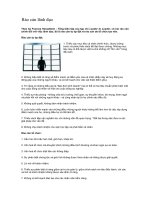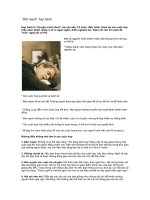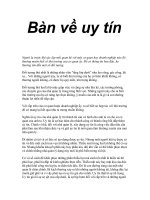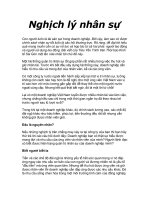Tài liệu NF EN ISO 5167-4 ppt
Bạn đang xem bản rút gọn của tài liệu. Xem và tải ngay bản đầy đủ của tài liệu tại đây (327.19 KB, 33 trang )
AFNOR
Association Française
de Normalisation
www.afnor.fr
Toute reproduction ou représentation
intégrale ou partielle, par quelque
procédé que ce soit, des pages publiées
dans le présent document, faite sans
l'autorisation de l'éditeur est illicite et
constitue une contrefaçon. Seules sont
autorisées, d'une part, les reproductions
strictement réservées à l'usage privé
du copiste et non destinées à une
utilisation collective et, d'autre part,
les analyses et courtes citations
justifiées par le caractère scientifique
ou d'information de l'œuvre dans
laquelle elles sont incorporées (Loi du
1
er
juillet 1992 – art. L 122-4 et L 122-5,
et Code Pénal art. 425).
Diffusé par
NF EN ISO 5167-4
juin 2003
Ce document est à usage exclusif et non collectif des clients AFNOR SAGAWEB.
Toute mise en réseau, reproduction et rediffusion, sous quelque forme que ce soit,
même partielle, sont strictement interdites.
This document is intended for the exclusive and non collective use of AFNOR SAGAWEB.
(Standards on line) customers. All network exploitation, reproduction and re-dissemination,
even partial, whatever the form (hardcopy or other media), is strictly prohibited.
SAGAWEB
Pour : TECHNIP FRANCE
le 20/1/2004 - 9:51
© AFNOR 2003 AFNOR 2003 1
st
issue 2003-06-P
©
AFNOR 2003 — All rights reserved
FE116891 ISSN 0335-3931
NF EN ISO 5167-4
June 2003
Classification index: X 10-102-4
European standard
French standard
Published and distributed by Association Française de Normalisation (AFNOR — French standard institute) — 11, avenue Francis de Pressensé —
93571 Saint-Denis La Plaine Cedex — Tel.: + 33 (0)1 41 62 80 00 — Fax: + 33 (0)1 49 17 90 00 — www.afnor.fr
ICS: 17.120.10
Measurement of fluid flow by means
of pressure differential devices inserted
in circular cross-section conduits running full
Part 4: Venturi tubes
F : Mesure de débit des fluides au moyen d'appareils déprimogènes insérés
dans des conduites en charge de section circulaire — Partie 4 : Tubes
de Venturi
D : Durchflussmessung von Fluiden mit Dosselgeräten in voll durchströmten
Leitungen mit Kreisquerschitt — Teil 4: Venturirohre
French standard approved
by decision of the Director General of AFNOR on May 20, 2003 taking effect on
June 20, 2003.
With parts 1, 2 and 3, this standard replaces the approved standard
NF EN ISO 5167-1, dated November 1995, and its amendment A1, dated
October 1998.
Correspondence
The European Standard EN ISO 5167-4:2003 has the status of French standard. It
reproduces in full the international standard ISO 5167-4:2003.
Analysis
One of the X 10-1... set of standards concerning the measurement of fluid flow in
closed conduits, this document specifies information on Venturi tubes. It shall be
used with part 1 of the standard (NF EN ISO 5167-1) that provides:
— general information concerning the measurement of fluid flow using pressure dif-
ferential devices;
— information relating to the calculation of flow and uncertainty of associated
measurements.
Descriptors
Technical International Thesaurus: flow measurement, fluid flow, pipe flow, ven-
turi tubes, measurement, expansibility factor, computation, uncertainty, installation.
Modifications
This document constitutes a technical revision with respect to the document replaced.
Corrections
SAGAWEB pour : TECHNIP FRANCE le 20/1/2004 - 9:51
NF EN ISO 5167-4:2003 — 2 —
National foreword
References to French standards
The correspondence between the standards figuring in the clause "Normative references" and the identical French
standards is as follows:
ISO 4006 : NF EN ISO 4006 (classification index: X 10-100)
ISO 5167-1 : NF EN ISO 5167-1 (classification index: X 10-102-1)
SAGAWEB pour : TECHNIP FRANCE le 20/1/2004 - 9:51
EUROPEAN STANDARD
NORME EUROPÉENNE
EUROPÄISCHE NORM
EN ISO 5167-4
March 2003
ICS 17.120.10 Supersedes EN ISO 5167-1:1995
English version
Measurement of fluid flow by means of pressure differential
devices inserted in circular cross-section conduits running full -
Part 4: Venturi tubes (ISO 5167-4:2003)
Mesure de débit des fluides au moyen d'appareils
déprimogènes insérés dans des conduites en charge de
section circulaire - Partie 4: Tubes de Venturi (ISO 5167-
4:2003)
Durchflussmessung von Fluiden mit Drosselgeräten in voll
durchströmten Leitungen mit Kreisquerschnitt - Teil 4:
Venturirohre (ISO 5167-4:2003)
This European Standard was approved by CEN on 20 February 2003.
CEN members are bound to comply with the CEN/CENELEC Internal Regulations which stipulate the conditions for giving this European
Standard the status of a national standard without any alteration. Up-to-date lists and bibliographical references concerning such national
standards may be obtained on application to the Management Centre or to any CEN member.
This European Standard exists in three official versions (English, French, German). A version in any other language made by translation
under the responsibility of a CEN member into its own language and notified to the Management Centre has the same status as the official
versions.
CEN members are the national standards bodies of Austria, Belgium, Czech Republic, Denmark, Finland, France, Germany, Greece,
Hungary, Iceland, Ireland, Italy, Luxembourg, Malta, Netherlands, Norway, Portugal, Slovak Republic, Spain, Sweden, Switzerland and
United Kingdom.
EUROPEAN COMMITTEE FOR STANDARDIZATION
COMITÉ EUROPÉEN DE NORMALISATION
EUROPÄISCHES KOMITEE FÜR NORMUNG
Management Centre: rue de Stassart, 36 B-1050 Brussels
© 2003 CEN All rights of exploitation in any form and by any means reserved
worldwide for CEN national Members.
Ref. No. EN ISO 5167-4:2003 E
SAGAWEB pour : TECHNIP FRANCE le 20/1/2004 - 9:51
EN ISO 5167-4:2003 (E)
2
Foreword
This document (EN ISO 5167-4:2003) has been prepared by Technical Committee ISO/TC 30
"Measurement of fluid flow in closed conduits" in collaboration with CMC.
This European Standard shall be given the status of a national standard, either by publication of
an identical text or by endorsement, at the latest by September 2003, and conflicting national
standards shall be withdrawn at the latest by September 2003.
This document supersedes EN ISO 5167-1:1995.
According to the CEN/CENELEC Internal Regulations, the national standards organizations of
the following countries are bound to implement this European Standard: Austria, Belgium, Czech
Republic, Denmark, Finland, France, Germany, Greece, Hungary, Iceland, Ireland, Italy,
Luxembourg, Malta, Netherlands, Norway, Portugal, Slovak Republic, Spain, Sweden,
Switzerland and the United Kingdom.
NOTE FROM CMC The foreword is susceptible to be amended on reception of the German
language version. The confirmed or amended foreword, and when appropriate, the normative
annex ZA for the references to international publications with their relevant European
publications will be circulated with the German version.
Endorsement notice
The text of ISO 5167-4:2003 has been approved by CEN as EN ISO 5167-4:2003 without any
modifications.
SAGAWEB pour : TECHNIP FRANCE le 20/1/2004 - 9:51
ISO 5167-4:2003(E)
© ISO 2003 — All rights reserved
iii
Contents
Page
Foreword ............................................................................................................................................................ iv
Introduction ........................................................................................................................................................ v
1
Scope...................................................................................................................................................... 1
2
Normative references ........................................................................................................................... 2
3
Terms and definitions........................................................................................................................... 2
4
Principles of the method of measurement and computation ........................................................... 2
5
Classical Venturi tubes......................................................................................................................... 3
5.1
Field of application ............................................................................................................................... 3
5.2
General shape ....................................................................................................................................... 3
5.3
Material and manufacture..................................................................................................................... 7
5.4
Pressure tappings................................................................................................................................. 7
5.5
Discharge coefficient, C ....................................................................................................................... 8
5.6
Expansibility [expansion] factor,
ε
...................................................................................................... 9
5.7
Uncertainty of the discharge coefficient C ....................................................................................... 10
5.8
Uncertainty of the expansibility [expansion] factor
ε
...................................................................... 10
5.9
Pressure loss....................................................................................................................................... 10
6
Installation requirements ................................................................................................................... 11
6.1
General ................................................................................................................................................. 11
6.2
Minimum upstream and downstream straight lengths for installation between various
fittings and the Venturi tube .............................................................................................................. 11
6.3
Flow conditioners ............................................................................................................................... 15
6.4
Additional specific installation requirements for classical Venturi tubes .................................... 15
Annex A (informative) Table of expansibility [expansion] factor ................................................................ 17
Annex B (informative) Classical Venturi tubes used outside the scope of ISO 5167-4............................. 18
Annex C (informative) Pressure loss in a classical Venturi tube ................................................................ 22
Bibliography ..................................................................................................................................................... 24
SAGAWEB pour : TECHNIP FRANCE le 20/1/2004 - 9:51
ISO 5167-4:2003(E)
iv
© ISO 2003 — All rights reserved
Foreword
ISO (the International Organization for Standardization) is a worldwide federation of national standards bodies
(ISO member bodies). The work of preparing International Standards is normally carried out through ISO
technical committees. Each member body interested in a subject for which a technical committee has been
established has the right to be represented on that committee. International organizations, governmental and
non-governmental, in liaison with ISO, also take part in the work. ISO collaborates closely with the
International Electrotechnical Commission (IEC) on all matters of electrotechnical standardization.
International Standards are drafted in accordance with the rules given in the ISO/IEC Directives, Part 2.
The main task of technical committees is to prepare International Standards. Draft International Standards
adopted by the technical committees are circulated to the member bodies for voting. Publication as an
International Standard requires approval by at least 75 % of the member bodies casting a vote.
Attention is drawn to the possibility that some of the elements of this document may be the subject of patent
rights. ISO shall not be held responsible for identifying any or all such patent rights.
ISO 5167-4 was prepared by Technical Committee ISO/TC 30, Measurement of fluid flow in closed conduits,
Subcommittee SC 2, Pressure differential devices.
This first edition of ISO 5167-4, together with the second edition of ISO 5167-1 and the first editions of
ISO 5167-2 and ISO 5167-3, cancels and replaces the first edition of ISO 5167-1:1991, which has been
technically revised, and ISO 5167-1:1991/Amd.1:1998.
ISO 5167 consists of the following parts, under the general title Measurement of fluid flow by means of
pressure differential devices inserted in circular cross-section conduits running full:
Part 1: General principles and requirements
Part 2: Orifice plates
Part 3: Nozzles and Venturi nozzles
Part 4: Venturi tubes
SAGAWEB pour : TECHNIP FRANCE le 20/1/2004 - 9:51
ISO 5167-4:2003(E)
© ISO 2003 — All rights reserved
v
Introduction
ISO 5167, divided into four parts, covers the geometry and method of use (installation and operating
conditions) of orifice plates, nozzles and Venturi tubes when they are inserted in a conduit running full to
determine the flowrate of the fluid flowing in the conduit. It also gives necessary information for calculating the
flowrate and its associated uncertainty.
ISO 5167 is applicable only to pressure differential devices in which the flow remains subsonic throughout the
measuring section and where the fluid can be considered as single-phase, but is not applicable to the
measurement of pulsating flow. Furthermore, each of these devices can only be used within specified limits of
pipe size and Reynolds number.
ISO 5167 deals with devices for which direct calibration experiments have been made, sufficient in number,
spread and quality to enable coherent systems of application to be based on their results and coefficients to
be given with certain predictable limits of uncertainty.
The devices introduced into the pipe are called “primary devices”. The term primary device also includes the
pressure tappings. All other instruments or devices required for the measurement are known as “secondary
devices”. ISO 5167 covers primary devices; secondary devices
1)
will be mentioned only occasionally.
ISO 5167 is divided into the following four parts.
a) Part 1 of ISO 5167 gives general terms and definitions, symbols, principles and requirements as well as
methods of measurement and uncertainty that are to be used in conjunction with Parts 2 to 4 of ISO 5167.
b) Part 2 of ISO 5167 specifies orifice plates, which can be used with corner pressure tappings, D and D/2
pressure tappings
2)
, and flange pressure tappings.
c) Part 3 of ISO 5167 specifies ISA 1932 nozzles
3)
, long radius nozzles and Venturi nozzles, which differ in
shape and in the position of the pressure tappings.
d) This part of ISO 5167 specifies classical Venturi tubes
4)
.
Aspects of safety are not dealt with in Parts 1 to 4 of ISO 5167. It is the responsibility of the user to ensure
that the system meets applicable safety regulations.
1) See ISO 2186:1973, Fluid flow in closed conduits — Connections for pressure signal transmissions between primary
and secondary elements.
2) Orifice plates with “vena contracta” pressure tappings are not considered in ISO 5167.
3) ISA is the abbreviation for the International Federation of the National Standardizing Associations, which was
succeeded by ISO in 1946.
4) In the USA the classical Venturi tube is sometimes called the Herschel Venturi tube.
SAGAWEB pour : TECHNIP FRANCE le 20/1/2004 - 9:51
SAGAWEB pour : TECHNIP FRANCE le 20/1/2004 - 9:51
INTERNATIONAL STANDARD ISO 5167-4:2003(E)
© ISO 2003 — All rights reserved
1
Measurement of fluid flow by means of pressure differential
devices inserted in circular cross-section conduits running
full —
Part 4:
Venturi tubes
1 Scope
This part of ISO 5167 specifies the geometry and method of use (installation and operating conditions) of
Venturi tubes when they are inserted in a conduit running full to determine the flowrate of the fluid flowing in
the conduit.
This part of ISO 5167 also provides background information for calculating the flowrate and is applicable in
conjunction with the requirements given in ISO 5167-1.
This part of ISO 5167 is applicable only to Venturi tubes in which the flow remains subsonic throughout the
measuring section and where the fluid can be considered as single-phase. In addition, each of these devices
can only be used within specified limits of pipe size, roughness, diameter ratio and Reynolds number. This
part of ISO 5167 is not applicable to the measurement of pulsating flow. It does not cover the use of Venturi
tubes in pipes sized less than 50 mm or more than 1 200 mm, or where the pipe Reynolds numbers are below
2 × 10
5
.
This part of ISO 5167 deals with the three types of classical Venturi tubes:
a) cast;
b) machined;
c) rough welded sheet-iron.
A Venturi tube is a device which consists of a convergent inlet connected to a cylindrical throat which is in turn
connected to a conical expanding section called the “divergent”. The differences between the values of the
uncertainty of the discharge coefficient for the three types of classical Venturi tube show, on the one hand, the
number of results available for each type of classical Venturi tube and, on the other hand, the more or less
precise definition of the geometric profile. The values are based on data collected many years ago. Venturi
nozzles (and other nozzles) are dealt with in ISO 5167-3.
NOTE 1 Research into the use of Venturi tubes in high-pressure gas [ W 1 MPa ( W 10 bar)] is being carried out at
present (see References [1], [2], [3] in the Bibliography). In many cases for Venturi tubes with machined convergent
sections discharge coefficients which lie outside the range predicted by this part of ISO 5167 by 2 % or more have been
found. For optimum accuracy Venturi tubes for use in gas should be calibrated over the required flowrate range. In high-
pressure gas the use of single tappings (or at most two tappings in each plane) is not uncommon.
NOTE 2 In the USA the classical Venturi tube is sometimes called the Herschel Venturi tube.
SAGAWEB pour : TECHNIP FRANCE le 20/1/2004 - 9:51
ISO 5167-4:2003(E)
2
© ISO 2003 — All rights reserved
2 Normative references
The following referenced documents are indispensable for the application of this document. For dated
references, only the edition cited applies. For undated references, the latest edition of the referenced
document (including any amendments) applies.
ISO 4006:1991, Measurement of fluid flow in closed conduits — Vocabulary and symbols
ISO 5167-1:2003, Measurement of fluid flow by means of pressure differential devices inserted in circular
cross-section conduits running full — Part 1: General principles and requirements
3 Terms and definitions
For the purposes of this document, the terms and definitions given in ISO 4006 and ISO 5167-1 apply.
4 Principles of the method of measurement and computation
The principle of the method of measurement is based on the installation of a Venturi tube into a pipeline in
which a fluid is running full. In a Venturi tube a static pressure difference exists between the upstream section
and the throat section of the device. Whenever the device is geometrically similar to one on which direct
calibration has been made, the conditions of use being the same, the flowrate can be determined from the
measured value of this pressure difference and from a knowledge of the fluid conditions.
The mass flowrate can be determined by the following formula:
2
1
4
2
4
1
m
C
qdp
ερ
β
π
=∆
−
(1)
The uncertainty limits can be calculated using the procedure given in Clause 8 of ISO 5167-1:2003.
Similarly, the value of the volume flowrate can be calculated since
m
V
q
q
ρ
=
where
ρ
is the fluid density at the temperature and pressure for which the volume is stated.
Computation of the flowrate, which is a purely arithmetic process, is performed by replacing the different items
on the right-hand side of Equation (1) by their numerical values. Table A.1 gives Venturi tube expansibility
factors (
ε
). They are not intended for precise interpolation. Extrapolation is not permitted.
The diameters
d
and
D
mentioned in Equation (1) are the values of the diameters at working conditions.
Measurements taken at any other conditions should be corrected for any possible expansion or contraction of
the primary device and the pipe due to the values of the temperature and pressure of the fluid during the
measurement.
It is necessary to know the density and the viscosity of the fluid at working conditions. In the case of a
compressible fluid, it is also necessary to know the isentropic exponent of the fluid at working conditions.
SAGAWEB pour : TECHNIP FRANCE le 20/1/2004 - 9:51
ISO 5167-4:2003(E)
© ISO 2003 — All rights reserved
3
5 Classical Venturi tubes
5.1 Field of application
5.1.1 General
The field of application of the classical Venturi tubes dealt with in this part of ISO 5167 depends on the way in
which they are manufactured.
Three types of standard classical Venturi tube are defined according to the method of manufacture of the
internal surface of the entrance cone and the profile at the intersection of the entrance cone and the throat.
These three methods of manufacture are described in 5.1.2 to 5.1.4 and have somewhat different
characteristics.
There are limits to the roughness and Reynolds number for each type which shall be addressed.
5.1.2 Classical Venturi tube with an “as cast” convergent section
This is a classical Venturi tube made by casting in a sand mould, or by other methods which leave a finish on
the surface of the convergent section similar to that produced by sand casting. The throat is machined and the
junctions between the cylinders and cones are rounded.
These classical Venturi tubes can be used in pipes of diameter between 100 mm and 800 mm and with
diameter ratios
β
between 0,3 and 0,75 inclusive.
5.1.3 Classical Venturi tube with a machined convergent section
This is a classical Venturi tube cast or fabricated as in 5.1.2 but in which the convergent section is machined
as are the throat and the entrance cylinder. The junctions between the cylinders and cones may or may not be
rounded.
These classical Venturi tubes can be used in pipes of diameter between 50 mm and 250 mm and with
diameter ratios
β
between 0,4 and 0,75 inclusive.
5.1.4 Classical Venturi tube with a rough-welded sheet-iron convergent section
This is a classical Venturi tube normally fabricated by welding. For larger sizes it may not be machined if the
tolerance required in 5.2.4 can be achieved, but in the smaller sizes the throat is machined.
These classical Venturi tubes can be used in pipes of diameter between 200 mm and 1 200 mm and with
diameter ratios
β
between 0,4 and 0,7 inclusive.
5.2 General shape
5.2.1 Figure 1 shows a section through the centreline of the throat of a classical Venturi tube. The letters
used in the text refer to those shown on Figure 1.
The classical Venturi tube is made up of an entrance cylinder A connected to a conical convergent section B,
a cylindrical throat C and a conical divergent section E. The internal surface of the device is cylindrical and
concentric with the pipe centreline. The coaxiality of the convergent section and the cylindrical throat is
assessed by visual inspection.
5.2.2 The minimum cylinder length, measured from the plane containing the intersection of the cone
frustum B with the cylinder A, may vary as a result of the manufacturing process (see 5.2.8 to 5.2.10). It is,
however, recommended that it be chosen to be equal to D.
SAGAWEB pour : TECHNIP FRANCE le 20/1/2004 - 9:51
ISO 5167-4:2003(E)
4
© ISO 2003 — All rights reserved
The entrance cylinder diameter D shall be measured in the plane of the upstream pressure tappings. The
number of measurements shall be at least equal to the number of pressure tappings (with a minimum of four).
The diameters shall be measured near each pair of pressure tappings, and also between these pairs. The
arithmetic mean value of these measurements shall be taken as the value of D in the calculations.
Diameters shall also be measured in planes other than the plane of the pressure tappings.
No diameter along the entrance cylinder shall differ by more than 0,4 % from the value of the mean diameter.
This requirement is satisfied when the difference in the length of any of the measured diameters complies with
the said requirement with respect to the mean of the measured diameters.
Key
1
conical convergent E
2 cylindrical throat, C
3 conical convergent B
4 entrance cylinder A
5 connecting planes
a
7° u
ϕ
u 15°
b
Flow direction
c
See 5.4.7
Figure 1 — Geometric profile of the classical Venturi tube
SAGAWEB pour : TECHNIP FRANCE le 20/1/2004 - 9:51









